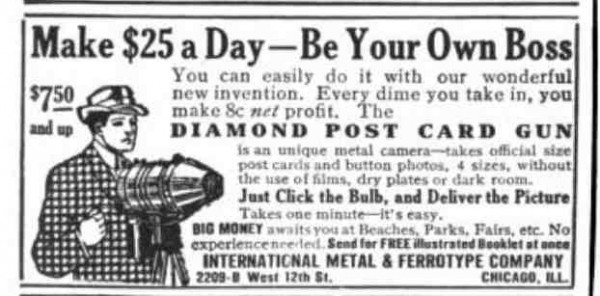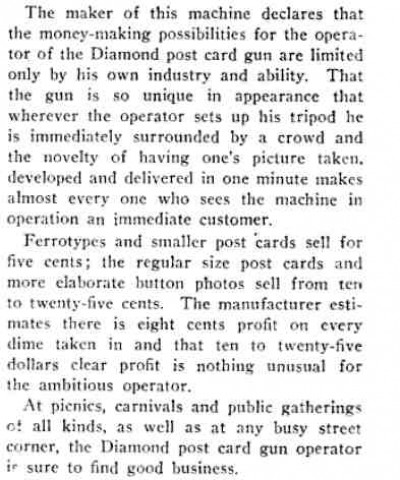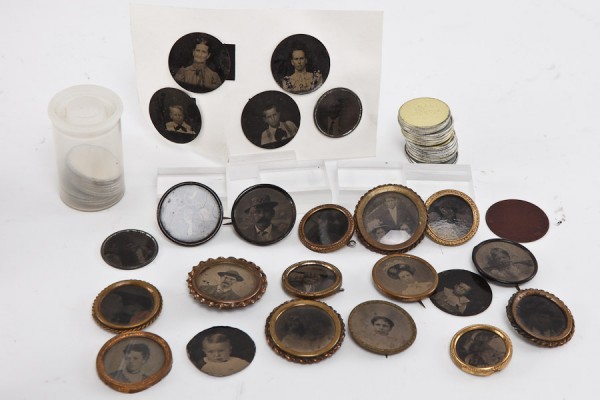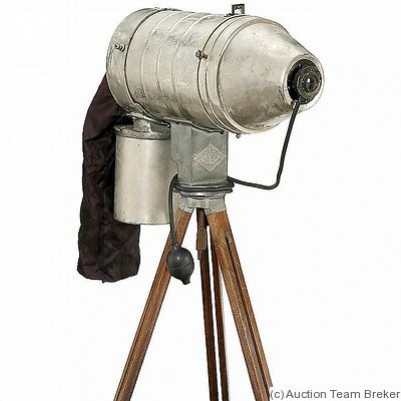Diamond Postcard Gun

Original ad here.

Original text here.
I am uncertain about how the technology of 1914 allowed for one-minute development of photos. But somehow they managed, as you can see from the buttons below.
And damn, that was one gorgeous hunk of equipment!


Comments
As an amateur film photographer, the developing process description using the word ferrotype rang a bell. I looked for the description of the ferrotype photographic process and I can tell you why it fell out of favor: the process used potassium cyanide.
It did work to develop images within the few minutes described, but I wouldn't want to work with it. 🐛
It did work to develop images within the few minutes described, but I wouldn't want to work with it. 🐛
Posted by KDP on 04/07/15 at 09:38 AM
Later versions of this setup exposed the paper directly and all the chemicals were in the housing of the camera. One of them was active up on the Acropolis at Athens through the 70s at least.
Posted by Expat47 in Athens, Greece on 04/07/15 at 10:20 AM
Great research, KDP. Thanks!
Expat--very neat memories of this process hanging on for so long.
Expat--very neat memories of this process hanging on for so long.
Posted by Paul on 04/07/15 at 11:29 AM
Cyanide! Careful or that could be your last picture! :gulp:
Posted by Patty in Ohio, USA on 04/07/15 at 11:57 AM
What amazes me is that this precedes the Polaroid 'instant camera' by over 40 years, and even came before Sam Schlafrock's patent (US 1559795 A) by about 10 years.
Posted by tadchem on 04/07/15 at 01:41 PM
Tad, your observation about Land's Polaroid process is correct. Land brought the development process together with the exposure process in a relatively neat package.
What many of the old photographic processes have in common is exposure of a photo / light sensitive compound (generally silver nitrate) held in a gel (collodion at first, gelatin later) coated onto a substrate (glass or paper) and using chemicals that react with the unexposed microscopic silver grains and dissolve it out of the gel, leaving the large silver grains behind to form the negative.
There were a half dozen or so processes in popular use until the Kodak company settled upon the cellulose film / paper print process that carried many amateur photographers along for years until the popularization of the modern electronic cameras.
What many of the old photographic processes have in common is exposure of a photo / light sensitive compound (generally silver nitrate) held in a gel (collodion at first, gelatin later) coated onto a substrate (glass or paper) and using chemicals that react with the unexposed microscopic silver grains and dissolve it out of the gel, leaving the large silver grains behind to form the negative.
There were a half dozen or so processes in popular use until the Kodak company settled upon the cellulose film / paper print process that carried many amateur photographers along for years until the popularization of the modern electronic cameras.
Posted by KDP on 04/07/15 at 04:12 PM
It looks like the tintype process, which was a relatively fast process. This company is still making them:
http://www.freestylephoto.biz/1832016-Rockland-Colloid-Tintype-Parlor-Kit
From their description:
"...tintypes were relatively inexpensive and it provided quick results."
"...re-creation of the tintype process, a type of “instant” photography."
http://www.freestylephoto.biz/1832016-Rockland-Colloid-Tintype-Parlor-Kit
From their description:
"...tintypes were relatively inexpensive and it provided quick results."
"...re-creation of the tintype process, a type of “instant” photography."
Posted by sudon't on 04/10/15 at 11:04 AM
Commenting is not available in this channel entry.

Category: Business | Hobbies and DIY | Photography and Photographers | 1910s